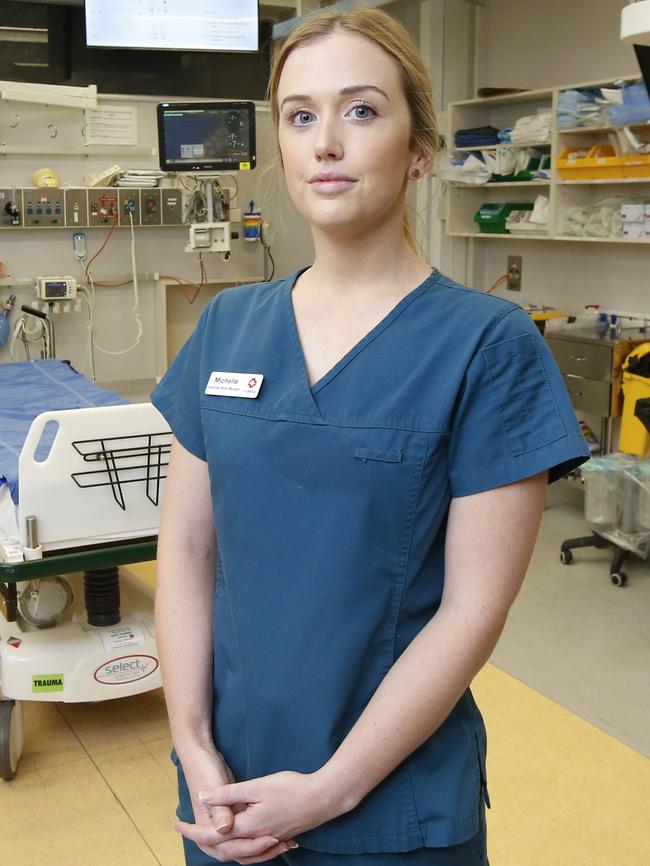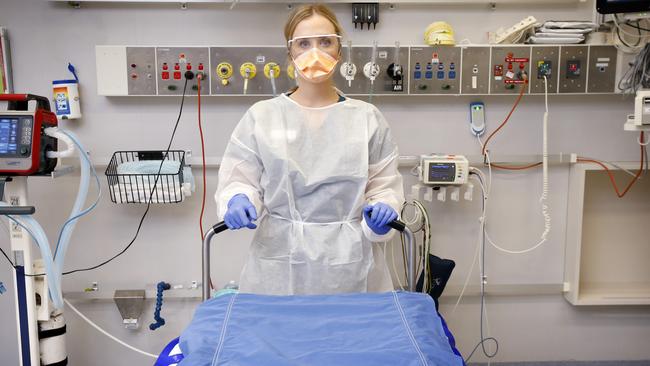An emergency nurse’s diary from The Alfred hospital’s coronavirus frontline
The Alfred hospital has been swamped since the coronavirus pandemic exploded, but its emergency department still finds light in the little moments, nurse Michelle Caulfield says. This is the one thing banned from the hospital’s tearoom, and how staff are keeping morale up.

VIC News
Don't miss out on the headlines from VIC News. Followed categories will be added to My News.
An uncharacteristically nice shift on Monday from 9.30pm-7.30am. Only seven or eight COVID-19 suspected cases, aged from their 40s to 90s, overnight.
One, an elderly woman, was confused and bit distressed. She was even more terrified on seeing us in our personal protective equipment (PPE) — mask, gloves, goggles and this white plasticky feeling gown, which is non-permeable.
The protection is alien and intimidating but you can still tell when people smile because you can see their eyes.

This lady’s primary nurse found a beautiful way to calm her down. About 2am, she started singing to her, old tunes, one after the other, while wearing her full PPE gear. It was so nice to see that human side. It’s been a very challenging time but it’s been far easier since we started a separate COVID-19 clinic on March 12 for those who do not need urgent medical care.
In the three days before, we had to test 700 patients. We say the swabs — like a cotton bud fed up the nose to the nasopharynx — are like tickling people’s brains. It was organised madness.
We have seen everyone and anyone. We put on the PPE for every suspected COVID-19 patient we see in an isolation cubicle, then remove it on leaving the room. It’s a lot of on and off. Lots of hand hygiene.
But I’m confident the protocols protect us. The public has been really good in that they are listening to the advice and not coming to emergency unless they need urgent care. We’ve seen people who have been overseas, who have come down with illnesses, and more and more people from nursing homes. We’ve seen it all.
The numbers change every hour and every day, it’s never the same. But the numbers feel like they are increasing shift to shift.
In two half-hour breaks per shift, we eat and talk. It helps with the grind. We constantly try to think of ways to keep morale high. For example, we have live streaming of Melbourne Zoo on screens. It’s nice to look at a cute penguin or lion for a minute and then get on with the job.
Due to the requirements of PPE, male staff have to shave their beards off so the masks have an adequate seal. They’ve all kept their moustaches as a little laugh and act of togetherness. We’re all in this together, and a bit of humour helps.
Patients are naturally concerned but fairly calm. This is a really stressful time for people, especially those more vulnerable. But we haven’t had panic.
I’ve been working in The Alfred emergency department for seven years now, and about four weeks ago became a supervising associate nurse manager. What a time to start. But the support of the clinical team is endless. To say I’m not concerned about what may or may not come would be a lie. My dad is immunocompromised, and it’s something that I do worry about. It’s just that fear of the unknown. We all just have to be so careful.
I finish at 7.30am and have some breakfast cereal. Who knows what my next shift will bring? It changes every day. That’s why we are in emergency. We like the unknown.

1PM-9.30PM THURSDAY
We did a lot of simulations to prepare for what lies ahead. We drilled in intubating critical COVID-19 patients in our personal protective equipment to make sure we’re safe, the patient is safe, and that therefore everyone else is safe.
We need to make sure the procedure — while wearing PPE — becomes second nature. We also refine PPE removal to make sure we’re not touching clean areas with dirty hands or equipment. We are making everything 110 per cent safe.
But it’s hitting home a bit with the simulations. Then being ready for what will come. It gives me goosebumps thinking about how well everyone is working together. It fills me with a lot of confidence.
The slightest thing, like a sore throat, means we have to test negative before we can go back to work. The protocols keep getting stricter. For example, we now see all patients, COVID-19 suspected or not, wearing gloves and masks.
We had about 15 to 20 COVID-19-suspected cases in emergency today. A real mixed bag of skittles. The youngest was in their 30s but happily none were super critical.

Only a handful were admitted. The rest were sent home with very strict self-isolation instructions. We are now requesting that those who are admitted, but fall short of being critical, do not have visitors.
It’s hard at the moment because so many colds and viruses are going around that fit the criteria. But better to be safe than sorry. That’s our motto: prepare for the worst and hope for the best.
On shift breaks, COVID-19 chatter is now banned in the tearoom. Just keep the mood up, that’s our goal, make sure everyone can smile and laugh.
I talked to one of the girls about my golden retrievers, Freddy and Murphy. That’s no surprise –—everyone knows that my dogs come up in every conversation. They are the lights of my life. They’re loving the home isolation and having my partner home. We don’t wear scrubs to and from work any more. I get undressed in the garage after a shift and run in and have a shower, and only then will I say hello to my partner, Steve. We’re taking every precaution possible.
On my next shift, Friday afternoon and night, you usually see an increase in alcohol-related presentations. But because the pubs and clubs have been shut, I felt like there was a lot less last weekend. So that’s a nice reprieve.
It’s a whole lot of unknown. I don’t know how many people will come in. It’s just a big waiting game.
FRIDAY 1PM-9.30PM
I heard about the COVID-19 deaths in the hospital’s haematology-oncology department on the news. That two patients died, and both patients and staff have been infected, is just devastating.
We are OK in the emergency department. I haven’t been among the 60 Alfred hospital staff tested and required to self-isolate because of the outbreak. I can only imagine how difficult it would be on the ward.
It has definitely made it feel more real. Although I don’t think we are completely safe from contracting the virus, I feel like we are doing absolutely everything we can to minimise risk to ourselves and patients by strictly following the guidelines from Department of Health and Human Services.
I might get COVID-19, but I don’t think it would be as a consequence of work, but more likely from the community — even though our house is in lockdown and my only excursions, bar work, are to the supermarket and to walk the dogs.
This was a challenging shift, even if alcohol-related trauma was — again — low for a Friday night. I was too busy to count the COVID-19-related cases, but it was 20 or more, aged from their 20s to the 90s. A real mixed bag, and some critical.
I spent an hour in head-to-toe “iso”. I had my hair net on, my mask, my goggles on, my booties on, my double gloves. Boy, it’s hot, and the mask digs in. But the teamwork is amazing.
Simulation is always different to real-time, however this shift showed that the planning and practising we have been doing so far has worked and I feel prepared.
There were a couple of critical patients who met the COVID-19 criteria but that wasn’t what they were in for. But we are treating any unknowns as a possibility. Our protocols are very isolation heavy. That’s the way it’s got to be from now on.
I was a bit late getting out. Driving home, I saw a building near Kings Way with its lights on in a big love heart. It was so nice to see after such an intense shift.
I got home about 11pm. My mind was go, go, go and it took a while to get to sleep. I was reflecting and anticipating. Thinking: “Yes, this is what we could be in for.”

SATURDAY 7AM-3.30PM
Up at 5am after about five hours of sleep. I’m used to the hours, and most of the team who worked last night were also rostered on this morning. I had a big chat with them before we went in to reflect on last night’s efforts. I wanted everyone to feel appreciated because they had all stepped up.
We then came on the floor bracing ourselves for more of last night. But it wasn’t like that. There were quite a few isolation patients coming in, probably 10-12 in the first few hours, but they were not critical. It felt like a little reprieve. It kind of ebbs and flows at the moment.
We had time to assess some of the lessons of last night’s shift. Like what we take into isolation rooms, what can be left out, because everything that goes in there must be discarded.
We’re used to high trauma and severe respiratory issues and high volume, but we are shifting our focus to make sure we are still there for everyone. And that means anyone who might have COVID-19 is treated as if they do. This is how it needs to be for the weeks and months ahead.
MORE NEWS
BEACHGOERS SLAMMED FOR SELFISH DISPLAY
